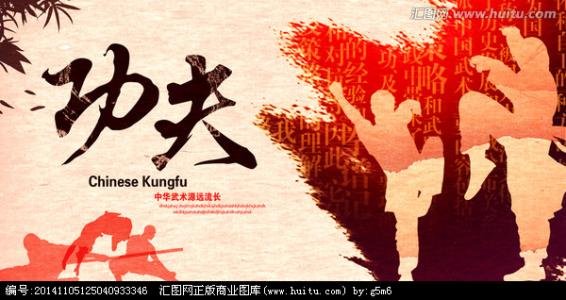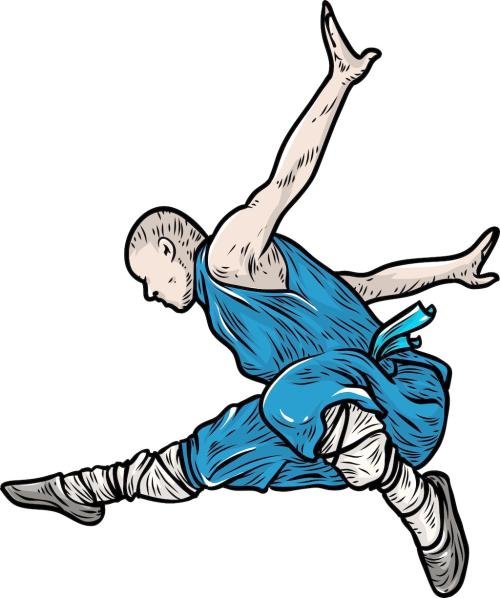Chinese Kung Fu
Martial arts, Kung Fu, also refers to the achievements of the military. For example: the arts and martial arts, martial arts high strength. The concept of Wushu is the basic basis for people to know and study Wushu. In the long historical process, the concept of Wushu has been expressed differently in different periods. Its connotation and denotation are developing and changing along with the development of social history and the development of Wushu itself. Historically, there are many names belonging to martial arts. In the spring and Autumn period and the Warring States, the "Wu Yi" was called in the Han Dynasty, and it was extended to the end of the Ming Dynasty. In the early Qing Dynasty, the word "martial arts" was used in the Southern Dynasty's "Wen Xuan" (then the military). In the Republic of China, the term "national skill" was called "martial arts" and also called martial arts.
 With the change of history, the gradual extinction of cold weapons, the production of special martial arts instruments and the emergence of a large number of boxing and weapons routines, the formulation of the rules of antagonism and Wushu competition, Wushu has evolved into one of the sports events. The athletics of Wushu has made great changes in its contents, forms and training methods, and the concept of reflecting the essential attributes of things has been changing. To the present, the basic definition of Wushu can be summarized as follows: Wushu is the main content of the martial arts, and the traditional Chinese sports with both internal and external training are focused on the form of routines and trapping. Qing Yuan Fu Chen "refurbishment of the first ancestor Rong Gong's portrait": "the first ancestor (Yuan Keli's ancestor) started with martial arts, the emperor of the Ming Dynasty exclaimed the Lord, seal Sui Yang Wei Zhao lieutenant, then home in the Sui, so far more than three hundred years."
With the change of history, the gradual extinction of cold weapons, the production of special martial arts instruments and the emergence of a large number of boxing and weapons routines, the formulation of the rules of antagonism and Wushu competition, Wushu has evolved into one of the sports events. The athletics of Wushu has made great changes in its contents, forms and training methods, and the concept of reflecting the essential attributes of things has been changing. To the present, the basic definition of Wushu can be summarized as follows: Wushu is the main content of the martial arts, and the traditional Chinese sports with both internal and external training are focused on the form of routines and trapping. Qing Yuan Fu Chen "refurbishment of the first ancestor Rong Gong's portrait": "the first ancestor (Yuan Keli's ancestor) started with martial arts, the emperor of the Ming Dynasty exclaimed the Lord, seal Sui Yang Wei Zhao lieutenant, then home in the Sui, so far more than three hundred years."
众所周知,中国功夫片从李小龙时代开始传播到国外,许多现代西方人从李小龙身上开始认识中国文化。如今,李小龙已成为一个功夫偶像、文化偶像和精神偶像,他的传奇人生成为跨文化传播的经典范例。 [1]
李小龙是一代功夫巨星和武术宗师,他一生许下并实现了三桩宏愿:让中国功夫走向世界,将中国电影带入世界市场,自创一门武术。现代西方人对中国武术与中国电影的认识几乎都是从李小龙开始。
 作为一个武者,李小龙终其一生都在为研究和发扬武术倾情尽力。他从几岁时便跟父亲李海泉学习太极拳,后跟专业武师梁子鹏学习内家拳,跟当时香港武术界领袖人物叶问学习咏春拳,跟节拳名家邵汉生学习节拳,跟武师严镜海学习肌力训练法,跟被称为“美国空手道之父”的艾得?帕克学习“肯波”流空手道,跟在美国武坛号称“柔术之父”的肯尼?拉贝尔学习柔术,跟有“美国跆拳道之父”美称的李俊九学习跆拳道,跟“菲律宾棍王”丹·伊鲁山度学习菲律宾武功……勤习中国拳术,钻研外国拳,李小龙以海纳百川的胸襟,融合各国多种门派诸多拳法的精华,武艺进展神速,并创立了截拳道。他在美国开国术馆传播咏春拳和截拳道,在各种演讲中讲述自己对中国武术的理解,跟世界各地的武术精英比武交流,写下了《截拳道》、《截拳道研究》、《功夫记录》、《二节棍法》、《布鲁斯-李拳术图解》(英文版)和《布鲁斯-李武打技法》(英文版)等著作手稿,为中华武术的的世界性传播作出了极大的贡献。美国、日本、英国、香港、台湾等国家或地区的很多报刊把他誉为“功夫之王”、“武之圣者”、“发扬中国武术最有成效的人”。 [1]
作为一个武者,李小龙终其一生都在为研究和发扬武术倾情尽力。他从几岁时便跟父亲李海泉学习太极拳,后跟专业武师梁子鹏学习内家拳,跟当时香港武术界领袖人物叶问学习咏春拳,跟节拳名家邵汉生学习节拳,跟武师严镜海学习肌力训练法,跟被称为“美国空手道之父”的艾得?帕克学习“肯波”流空手道,跟在美国武坛号称“柔术之父”的肯尼?拉贝尔学习柔术,跟有“美国跆拳道之父”美称的李俊九学习跆拳道,跟“菲律宾棍王”丹·伊鲁山度学习菲律宾武功……勤习中国拳术,钻研外国拳,李小龙以海纳百川的胸襟,融合各国多种门派诸多拳法的精华,武艺进展神速,并创立了截拳道。他在美国开国术馆传播咏春拳和截拳道,在各种演讲中讲述自己对中国武术的理解,跟世界各地的武术精英比武交流,写下了《截拳道》、《截拳道研究》、《功夫记录》、《二节棍法》、《布鲁斯-李拳术图解》(英文版)和《布鲁斯-李武打技法》(英文版)等著作手稿,为中华武术的的世界性传播作出了极大的贡献。美国、日本、英国、香港、台湾等国家或地区的很多报刊把他誉为“功夫之王”、“武之圣者”、“发扬中国武术最有成效的人”。 [1]
李小龙一生只拍过二十多部电影、电视,但他确让中国功夫走向世界,将中国电影带入世界市场。一部30集电视连续剧《青蜂侠》让西方人在荧屏上见识了中国功夫,李小龙一举成名。此后,他主演的《唐山大兄》、《精武门》、《龙争虎斗》、《猛龙过江》、《死亡游戏》等功夫片风行海外,中国功夫也随之闻名于世界,各国观众欣赏并痴迷中国武术,许多外文字典和词典里也出现了“功夫”(kongfu)这个新词,他也成为世界华人第一功夫巨星。1972年他被香港评为十大明星之一;1993年,美国好莱坞名人大道铺上李小龙纪念星徽;1998年,中国武协授予李小龙“国际武术巨星奖”;2005年,他获“中国电影走向世界杰出贡献奖”,当选“中国电影百年百位优秀演员”,获国家“中外文化交流突出贡献奖”;2007年,入选英国Total Film杂志“50大电影英雄”。